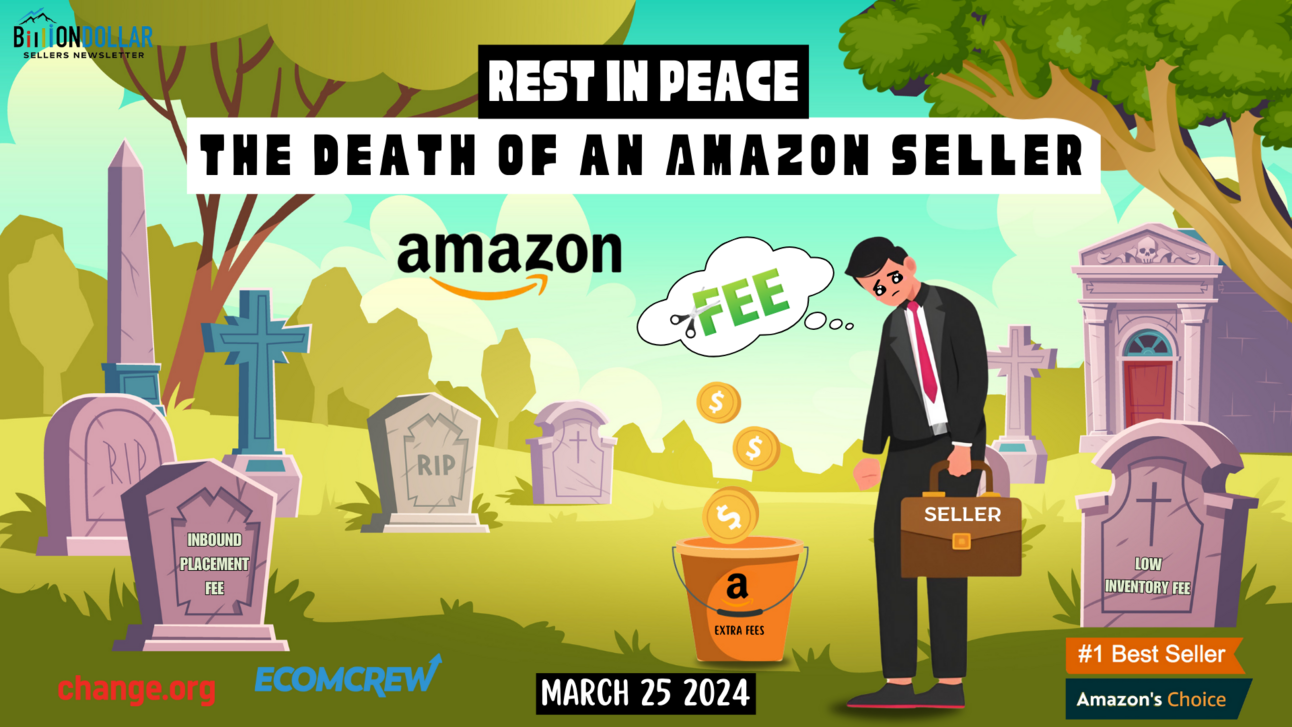


🪦 HERE RESTS a HUSTLER TRYING to MAKE a BUCK
-
⚰️ Amazon puts on the squeeze – will you survive?
-
🥷 Ninja tips & hacks you can’t afford to miss on Thursday
-
📛 Which converts better: Amazon’s Choice or Best Seller?
-
🏧 5 ways to get more cashflow on Amazon today
-
📖 Understanding first-party Seller Central data reports

 |
STUMP BEZOSAmazon’s original company name was “Cadabra.” What was the original name of Google (Alphabet)? [ Answer at bottom of email ] |

WARNING: The top 3 hacks will be omitted from the replay → show up live
“Get an infinite number of reviews on your listing”
– hack submitted for Thursday’s BDSN hack contest
When: Thursday, March 28
Time: 1pm ET / 10am PT
Where: online by Zoom – It’s FREE
Some of the 20+ hacks already submitted include:
• Get Infinite Reviews Hack
• Prime Day Sales Skyrocketing Hack
• PRE-load your launch with OTHER people’s products
• Boost conversion with a “Recommended By” label
• Boost sales by enhancing your images in 1 minute
• TikTok Shop: Product Review Profit Spiral




⚰️ AMAZON PUTS on the SQUEEZE – WILL YOU SURVIVE?
As Michael Patron wrote recently on X about Amazon’s new fees, ”these are gonna F*** some of ya’ll up.” Amazon raised all FBA fees Feb 5th and is recalculating them again on April 15th.
Michael says Amazon ain’t playing fair either. Over the last year, Amazon has allowed their own brands to take the #1 search result (a paid placement that Amazon locks their own item into). 3P sellers are not able to do this.

Fortune recently dove into the new fees issue and published an article highlighting the results of discussions with 20 longtime US-based Amazon sellers illuminating a critical juncture in the Amazon marketplace ecosystem.
❝
Amazon sellers say their businesses are facing an extinction event
— they might not be wrong
The fees in question include an “inbound placement fee” and a “low inventory” fee, which complicate the logistics and financial planning for sellers.
The inbound placement fee mandates sellers distribute their inventory across multiple Amazon facilities, a task that introduces both complexity and increased costs, particularly for smaller sellers.
The low inventory fee, on the other hand, penalizes sellers for not maintaining adequate stock levels, adding another layer of financial pressure.
Sellers are voicing their frustrations, emphasizing the intricacies and variability of these fees, which seem to require advanced understanding to manage.

Despite Amazon’s claims these changes could lead to reduced fees for some, the overall sentiment is one of apprehension and dissatisfaction.
The introduction of Amazon Warehousing and Distribution (AWD) is seen as a potential workaround, but it’s not a viable solution for all sellers, especially those with oversized products or those already committed to other solutions.
The fear is that these changes could lead to a significant thinning of the ranks of Amazon sellers, impacting the diversity and richness of the marketplace.
❝
Amazon collected $140 billion in fees from sellers last year. Now many are fuming over ‘crazy’ new fees they say tighten Amazon’s grip on their businesses
As Abe Chomali recently wrote, “At most, 25% of sellers understand their fees, and the other 75% just get their batches, do business-y stuff, and get the next batch, not understanding their profitability at all.”
-
for the next six months sellers who understand their costs will suffer as they try to remain competitive with sellers that are losing money.
-
the six months after that will see all the clueless sellers crashing and potentially going out of business – this might look like prices crashing as sellers suddenly need cash, it might look like huge spikes in price, it might look like a lot fewer advertisers as sellers cut out costs.
-
after those two phases, the sellers who have been carefully managing their businesses will be the last ones standing, and will be able to raise their prices and recoup their losses with appropriate price raises.

Jon Derkits says US-based Amazon sellers have always been structurally disadvantaged relative to China-based sellers.
He says China-based sellers almost universally have:
But with the new FBA Inbound Placement fees, US-based sellers can add “Inbound Logistics Costs” to the list of structural disadvantages.


If you’d like to voice your concern, there is a petition on change.org.

🌎 STATS YOU SHOULD KNOW


📛 AMAZON’S CHOICE or BEST SELLER?
Amazon badges are crucial in creating a sense of trust and perceived value to help your products stand out in search.
Many different kinds of badges can help you with conversions on Amazon:

What this email forwarded to you?

🏧 5 WAYS to GET MORE CASH FLOW on AMAZON TODAY
Izzy Benoliel says many businesses focus only on metrics like revenue, growth, net profit and ROI. While those are all important, cash flow is the most essential metric for any business.
If you don’t manage it correctly, your business won’t survive, regardless of how high your profits are.
MyAmazonGuy recently shared that a staggering 41% of its agency client cancellations came from growing brands that ran out of cash.

The top reason businesses fail is due to cash flow problems.
-
82% of small businesses that fail experience cash flow problems
-
42% find an insufficient need for their product or service
-
29% run out of cash
-
23% don’t have the right team
-
19% are out-competed.
Cash today is worth more than cash in a month. Always.

5 things you can do to improve your cashflow:
#1 Ask Amazon to increase your billing threshold for PPC spend
Most people don’t know that you can ask Amazon to increase the open balance limit up to $10,000 so you won’t have to pay until you reach $10K in spend.
#2 Not all credit cards are created equal – get more time to pay
At bankrate.com multiple business cards offered offer 0% interest on purchases for the first 12-15 months.
#3 Pay for anything with a credit card using a service like Melio
Melio Payments allows you to pay even suppliers in China for a fee (about 2.9%), which can be partially offset by your card rewards.
#4 Renegotiate better terms with your suppliers
Standard payment terms are 30% upfront and 70% on shipment. The key to improving those are a shared growth plan with your supplier and relationships.
#5 Convert returns into cash and use services like Getida



📖 UNDERSTANDING SELLER CENTRAL REPORTS
Helium 10 and Envision Horizons have released a nifty 43-page PDF on how to use all the first-party data Amazon has now made available to brand-registered sellers in Seller Central.
The free report includes how to use each report with actionable insights and highlights, plus an advanced use case for each.

🥃 PARTING SHOT
“Your diet isn’t just what you eat. It’s also what you read, watch and listen to. It’s all the information you consume that makes you who you are.”

✌🏼 See you again on Thursday …

The answer to today’s STUMP BEZOS is
“Backrub”










